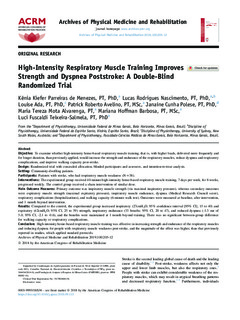| dc.contributor.author | de Menezes, Kênia Kiefer Parreiras | |
| dc.contributor.author | Nascimento, Lucas Rodrigues | |
| dc.contributor.author | Ada, Louise | |
| dc.contributor.author | Avelino, Patrick Roberto | |
| dc.contributor.author | Polese, Janaine Cunha | |
| dc.contributor.author | Alvarenga, Maria Tereza Mota | |
| dc.contributor.author | Barbosa, Mariana Hoffman | |
| dc.contributor.author | Teixeira-Salmela, Luci Fuscaldi | |
| dc.date.accessioned | 2019-06-25T17:52:07Z | |
| dc.date.available | 2019-06-25T17:52:07Z | |
| dc.date.issued | 2019 | |
| dc.identifier.citation | Kênia Kiefer Parreiras de Menezes, Lucas Rodrigues Nascimento, Louise Ada, Patrick Roberto Avelino, Janaine Cunha Polese, Maria Tereza Mota Alvarenga, Mariana Hoffman Barbosa, Luci Fuscaldi Teixeira-Salmela, High-Intensity Respiratory Muscle Training Improves Strength and Dyspnea Poststroke: A Double-Blind Randomized Trial, Archives of Physical Medicine and Rehabilitation, Volume 100, Issue 2, 2019, Pages 205-212,ISSN 0003-9993 | nb_NO |
| dc.identifier.uri | http://hdl.handle.net/11250/2602189 | |
| dc.description.abstract | Objective
To examine whether high-intensity home-based respiratory muscle training, that is, with higher loads, delivered more frequently and for longer duration, than previously applied, would increase the strength and endurance of the respiratory muscles, reduce dyspnea and respiratory complications, and improve walking capacity post-stroke.
Design
Randomized trial with concealed allocation, blinded participants and assessors, and intention-to-treat analysis.
Setting
Community-dwelling patients.
Participants
Patients with stroke, who had respiratory muscle weakness (N=38).
Interventions
The experimental group received 40-minute high-intensity home-based respiratory muscle training, 7 days per week, for 8 weeks, progressed weekly. The control group received a sham intervention of similar dose.
Main Outcome Measures
Primary outcome was inspiratory muscle strength (via maximal inspiratory pressure), whereas secondary outcomes were expiratory muscle strength (maximal expiratory pressure), inspiratory muscle endurance, dyspnea (Medical Research Council score), respiratory complications (hospitalizations), and walking capacity (6-minute walk test). Outcomes were measured at baseline, after intervention, and 1 month beyond intervention.
Results
Compared to the control, the experimental group increased inspiratory (27cmH2O; 95% confidence interval [95% CI], 15 to 40) and expiratory (42cmH2O; 95% CI, 25 to 59) strength, inspiratory endurance (33 breaths; 95% CI, 20 to 47), and reduced dyspnea (-1.3 out of 5.0; 95% CI, -2.1 to -0.6), and the benefits were maintained at 1 month beyond training. There was no significant between-group difference for walking capacity or respiratory complications.
Conclusion
High-intensity home-based respiratory muscle training was effective in increasing strength and endurance of the respiratory muscles and reducing dyspnea for people with respiratory muscle weakness post-stroke, and the magnitude of the effect was higher, than that previously reported in studies, which applied standard protocols. | nb_NO |
| dc.publisher | Archives of Physical Medicine and Rehabilitation | nb_NO |
| dc.subject | breathing exercises | nb_NO |
| dc.subject | cerebrovascular disease | nb_NO |
| dc.subject | clinical trial | nb_NO |
| dc.subject | dyspnea | nb_NO |
| dc.subject | exercise | nb_NO |
| dc.subject | muscle strength | nb_NO |
| dc.subject | rehabilitation | nb_NO |
| dc.subject | stroke | nb_NO |
| dc.title | High-Intensity Respiratory Muscle Training Improves Strength and Dyspnea Poststroke: A Double-Blind Randomized Trial | nb_NO |
| dc.type | Journal article | nb_NO |
| dc.source.pagenumber | 205-212 | nb_NO |
| dc.source.volume | 100 | nb_NO |
| dc.source.journal | Archives of Physical Medicine and Rehabilitation | nb_NO |
| dc.source.issue | 2 | nb_NO |
| dc.identifier.doi | https://doi.org/10.1016/j.apmr.2018.09.115 | |
| dc.description.localcode | måsjekkes | |
